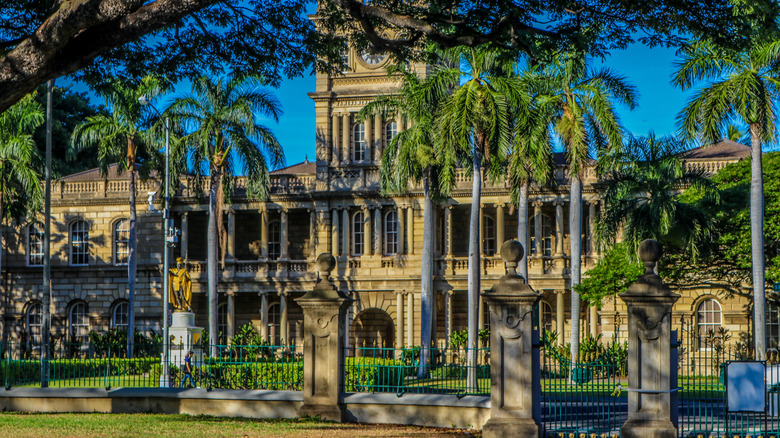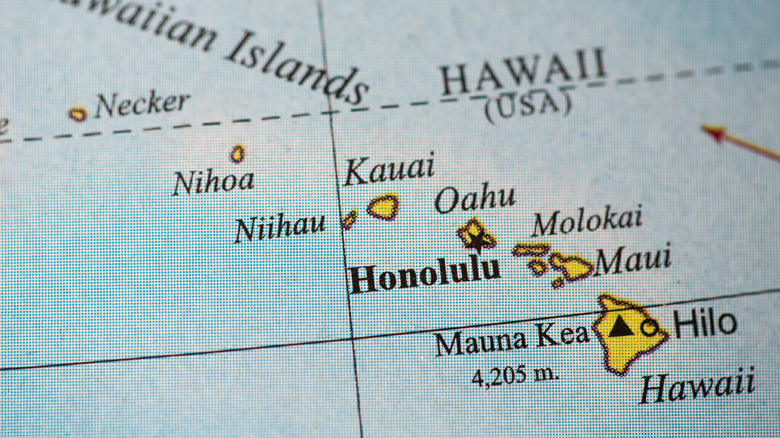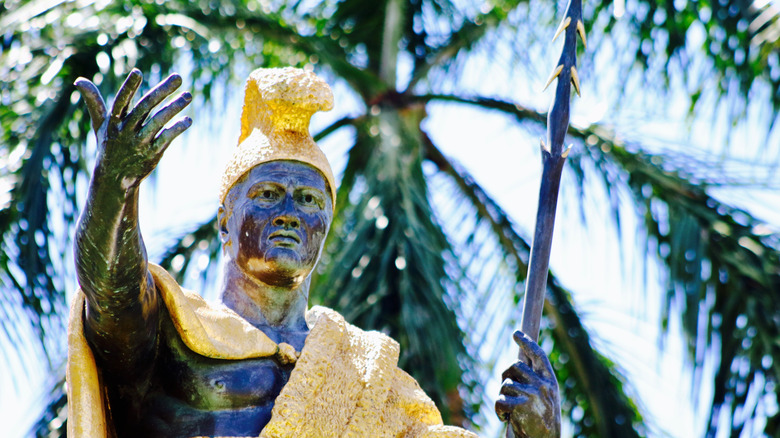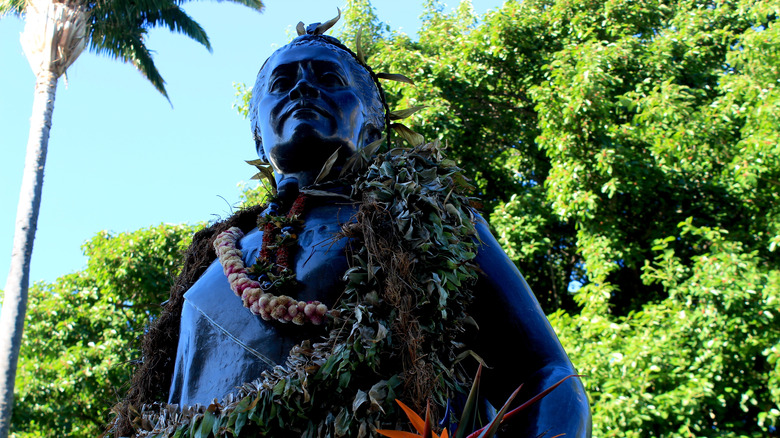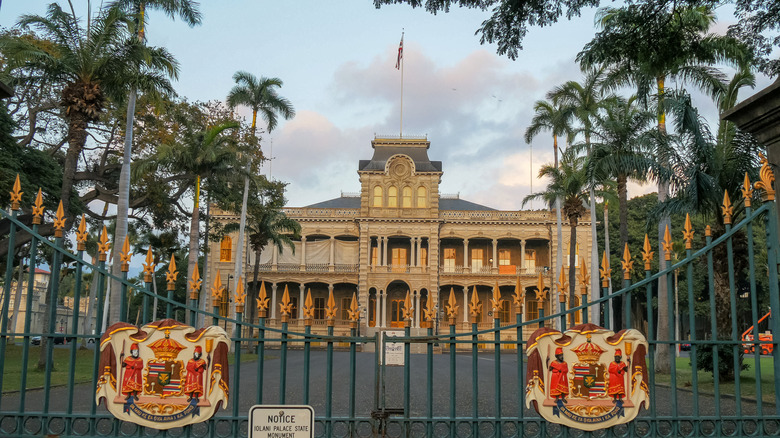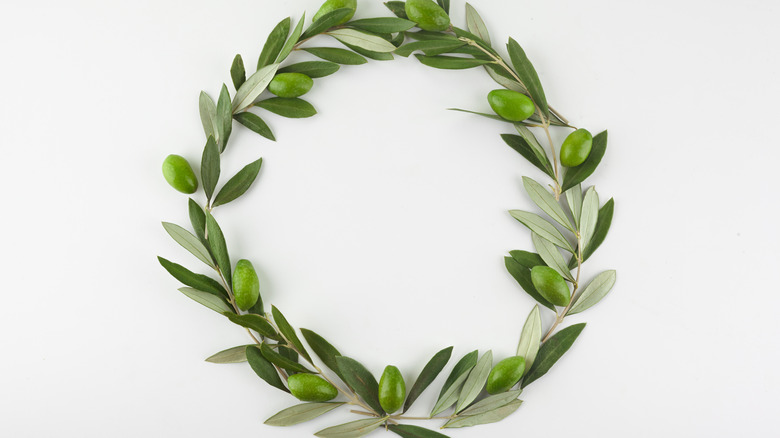This Is The Only Place In The Entire United States With A Royal Palace
The United States of America officially divorced itself from royalty in 1776, when the Declaration of Independence told King George III to take a hike and that the former colonies would get on without him. George, of course, didn't take that news lying down, and it took a bloody and protracted war to make the divorce final, but nevertheless, since 1783, the U.S. has been a republic (which is to say, not governed by a monarch).
Of course, in 1783, the United States didn't extend past the Mississippi River, to say nothing of halfway across the Pacific Ocean. And indeed, it wasn't even until five years later – 1788 – that a European first "discovered" Hawai'i (though it had been there all along). It took a couple more centuries before the archipelago became a part of the U.S., but for a time before the paperwork was completed, Hawai'i was a monarchy, albeit for only a few decades (via Teachinghistory.org). And like all monarchies, Hawai'i had palaces. One of those (Iolani Palace, pictured above) is still standing.
Hawai'i's Ugly Colonial History
The first human inhabitants to occupy what is now known as the Hawai'ian islands likely arrived there as early as the end of the 4th century, according to Smithsonian Magazine. For the next few centuries, governance of the archipelago consisted of local chieftains managing their own territory and sometimes going to war with other chieftains for territorial gains.
Europeans arrived in 1778 when Captain James Cook paid a visit. Unfortunately for Cook, his relationship with the island chain was short-lived: When he returned a year later, he was killed in a confrontation with the locals. In 1820, Christian missionaries arrived, and along with Christianity, they brought Western diseases that the Hawai'ian immune systems couldn't fight off, decimating the population. Before 1820, the population of the archipelago was estimated to be about 300,000. Within three decades, it was down to 70,000.
It wasn't only missionaries and explorers interested in the island chain. Sugar manufacturers also set up shop, and by 1893, the entire region's economy was dominated by the sugar industry. Hawai'i became a U.S. territory in 1898, would later become a strategic military location thanks to Pearl Habor, and in 1959, became the 50th state.
King Kamehameha Unites The Islands
As mentioned previously, for centuries, the inhabitants of the Hawai'ian islands largely lived in self-governing local groups. That all began to change in the late 1700s when a man who would later come to be known as King Kamehameha I (a statue of whom is pictured above) began to unify the islands, possibly motivated by Cook's colonial ambitions (via Go Hawai'i). Equipped with Western weapons, Kamehameha embarked on an ultimately-successful 15-year campaign of uniting the islanders under his rule.
Eventually, the new king moved into a royal palace/government headquarters in Honolulu, but the living quarters soon fell into disrepair (per the National Park Service). In 1879, then-King Kalakaua set about to rebuild the royal palace in a more Western style, inspired by the European estates he had seen while on a trip to the continent. Hawai'i's monarchy was overthrown in 1893 — at the behest of, and with the help of, American sugar plantation interests — and in 1898, the archipelago was annexed as a U.S. territory. The royal palace remains, however, the only such building anywhere in the United States.
Iolani Palace Falls Into Disrepair
Queen Lili'uokalani (pictured above) was Hawai'i's first, last, and only queen, occupying the throne when the archipelago's monarchy was overthrown by American commercial interests (via the National Park Service). She may or may not have been a part of a counter-revolution intended to restore the monarchy — she denied it but was nevertheless convicted and sentenced to house arrest — but after her imprisonment, she retreated to a quiet life in another home.
The palace became a temporary home of the archipelago's new government, and most of the items within were auctioned off. By the late 1960s, the palace had fallen into disrepair. However, a private group, Friends of Iolani Palace — with the cooperation of another private group, the Junior League of Honolulu — researched what the building would have looked like in its heyday and set about restoring it. By 1978, the palace was restored "to its 19th-century splendor," as the Park Service describes it, and it was opened to the general public as a museum.
The Iolani Palace Today
Today, you can take a tour of Iolani Palace for about $25, give or take, according to the museum's website. Unlike just about any other tourist attraction in this country, visitors are asked to remove their shoes and wear protective coverings; that's because the floors are made of fir, a soft wood that is easily susceptible to damage (via The Seattle Times). Visitors are also asked to behave in a manner consistent with touring any other royal palace, including by being dressed appropriately, lowering their voices, and of course, not touching anything and not going into off-limits areas.
The palace (as closely as possible) mimics what it might have looked like in its heyday. Some of the items inside are original, some reproductions, and some lost forever. For example, the Gold Room is (or was as of 2011) sparsely decorated. "Visitors [are asked] to use their imagination in the Gold Room, where the king and family members or guests would enjoy music. The ... gold carpet and drapes that once adorned the room have never been retrieved," The Seattle Times reports.
Other stops on the tour include the Grand Hall, the Throne Room, the Blue Room, and the King's Office, among others.
Hawai'i Still Has A Monarchy — Kind Of
The Hawai'ian monarchy may have officially dissolved over a century ago, but that doesn't mean that the descendants of its kings and queens have given up on the notion that they remain the archipelago's royal family. They even have the Royal Family Of Hawai'i Official Website. And a woman named Owana Kaʻōhelelani claims to be the descendant of the last monarchs of Hawai'i, explaining her descent on the royal family's website and how and why she is the rightful head of the quasi-monarchy. Kaʻōhelelani, who styles herself "Her Royal Highness Princess Owana Kaʻōhelelani," claims that she is the monarch whether the monarchy exists or not. "International Law based on Natural Law provides that the most lawful claim to the throne or head of the royal house can continue their royal prerogatives ... [she maintains] the right to maintain royal titles and the right to appoint royal titles and honors, even under a deposed kingdom," she (or her biographer) writes on her website.
Owana Kaʻōhelelani maintains a schedule of events that a monarch in, say, modern Europe would — fundraisers and such — and when she appears, she's dressed in royal finery. Of course, this is all unofficial, and how seriously she's taken will vary from Hawai'ian to Hawai'ian. For whatever it's worth, Hawai'i's constitution makes no mention of having a monarch, even ceremonially.
